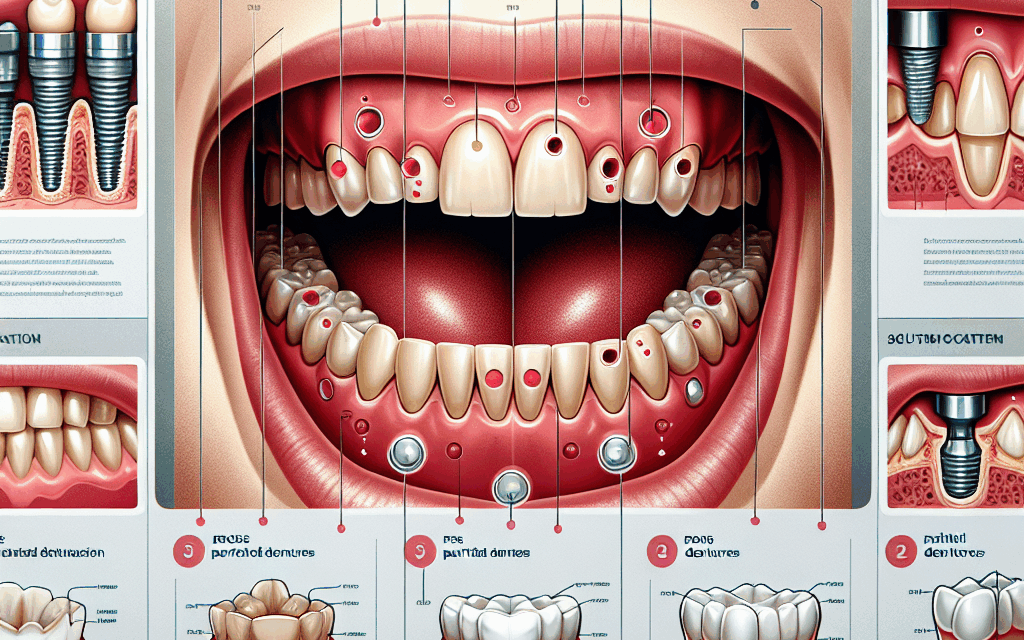Options for Addressing Missing Teeth: A Comprehensive Guide
Missing teeth can significantly impact an individual’s quality of life, affecting not only their ability to chew and speak but also their self-esteem and overall health. Fortunately, modern dentistry offers a variety of solutions to address this common issue. This comprehensive guide will explore the various options available for replacing missing teeth, including dental implants, bridges, dentures, and more. Each option will be examined in detail, providing insights into their benefits, drawbacks, and suitability for different patients.
1. Understanding the Impact of Missing Teeth
Before delving into the solutions for missing teeth, it is essential to understand the implications of tooth loss. Missing teeth can lead to a range of physical and psychological issues, including:
- Functional Impairments: Missing teeth can hinder chewing and speaking, making it difficult to consume a balanced diet and communicate effectively.
- Bone Loss: The jawbone requires stimulation from teeth to maintain its density. When teeth are lost, the bone can begin to deteriorate, leading to further dental issues.
- Shifting Teeth: Adjacent teeth may shift into the gap left by a missing tooth, leading to misalignment and bite problems.
- Psychological Effects: The aesthetic impact of missing teeth can lead to decreased self-esteem and social withdrawal.
- Increased Risk of Gum Disease: Gaps in the teeth can trap food particles and bacteria, increasing the risk of gum disease and other oral health issues.
Understanding these impacts underscores the importance of addressing missing teeth promptly and effectively. The following sections will explore the various options available for tooth replacement.
2. Dental Implants: The Gold Standard
Dental implants are often considered the gold standard for replacing missing teeth due to their durability, functionality, and aesthetic appeal. An implant consists of a titanium post that is surgically placed into the jawbone, serving as a replacement root for the missing tooth. Once the implant integrates with the bone, a crown is placed on top to complete the restoration.
Benefits of Dental Implants
Dental implants offer numerous advantages, including:
- Natural Appearance: Implants are designed to look and feel like natural teeth, providing a seamless aesthetic.
- Durability: With proper care, dental implants can last a lifetime, making them a cost-effective solution in the long run.
- Bone Preservation: Implants stimulate the jawbone, preventing bone loss and maintaining facial structure.
- Improved Functionality: Patients with implants can eat and speak without the discomfort often associated with dentures.
- Convenience: Unlike dentures, implants do not require adhesives or special cleaning solutions.
Considerations and Drawbacks
While dental implants are an excellent option for many, they may not be suitable for everyone. Some considerations include:
- Surgical Procedure: The placement of dental implants requires surgery, which may not be suitable for patients with certain health conditions.
- Time-Consuming: The process can take several months, as it involves healing time for the implant to integrate with the bone.
- Cost: Dental implants can be more expensive than other options, although many consider them a worthwhile investment.
Case Studies and Success Rates
Numerous studies have demonstrated the success rates of dental implants. According to the American Academy of Implant Dentistry, the success rate for dental implants is approximately 95% after 10 years. Case studies show that patients who have undergone implant procedures report high satisfaction levels, with many noting improved quality of life and confidence.
Who is a Good Candidate?
Ideal candidates for dental implants are those with:
- Good overall health and oral hygiene practices.
- Sufficient bone density to support the implant.
- No active gum disease or other oral health issues.
Patients who do not meet these criteria may still explore alternative options, which will be discussed in the following sections.
3. Dental Bridges: A Reliable Alternative
Dental bridges are another popular option for replacing missing teeth. A bridge consists of one or more artificial teeth (pontics) anchored to adjacent natural teeth (abutments) using crowns. This option is particularly suitable for patients who may not be candidates for implants due to health issues or insufficient bone density.
Types of Dental Bridges
There are several types of dental bridges, including:
- Traditional Bridges: These are the most common type and involve crowns placed on the adjacent teeth.
- Cantilever Bridges: Used when there is only one adjacent tooth available for support.
- Maryland Bridges: These consist of a metal framework with wings that bond to the back of adjacent teeth, requiring less alteration of the natural teeth.
Benefits of Dental Bridges
Dental bridges offer several advantages, such as:
- Restoration of Function: Bridges restore the ability to chew and speak properly.
- Improved Aesthetics: They provide a natural-looking solution for missing teeth.
- Quick Procedure: The process typically takes only a few visits to complete.
Considerations and Drawbacks
Despite their benefits, dental bridges also have some drawbacks:
- Impact on Adjacent Teeth: The procedure requires altering the adjacent teeth, which may compromise their integrity.
- Potential for Future Issues: If the supporting teeth develop problems, the bridge may need to be replaced.
- Limited Longevity: Bridges typically last 5-15 years, depending on oral hygiene and care.
Who is a Good Candidate for Dental Bridges?
Patients who may benefit from dental bridges include those who:
- Have one or more missing teeth but sufficient healthy adjacent teeth.
- Prefer a quicker solution than dental implants.
- Are not candidates for implants due to health or bone density issues.
4. Dentures: A Versatile Solution
Dentures are removable appliances designed to replace missing teeth and surrounding tissues. They can be complete (replacing all teeth) or partial (replacing some teeth). Dentures are a versatile option for individuals who may not be suitable candidates for implants or bridges.
Types of Dentures
There are two main types of dentures:
- Complete Dentures: These are used when all teeth are missing and are custom-made to fit the patient’s mouth.
- Partial Dentures: These are used when some natural teeth remain and are designed to fill in the gaps.
Benefits of Dentures
Dentures offer several benefits, including:
- Affordability: Dentures are generally less expensive than dental implants and bridges.
- Quick Solution: The process of getting dentures is typically faster than that of implants.
- Non-Invasive: Dentures do not require surgery, making them suitable for a broader range of patients.
Considerations and Drawbacks
However, dentures also come with some challenges:
- Comfort Issues: Some patients may experience discomfort or difficulty adjusting to wearing dentures.
- Maintenance: Dentures require regular cleaning and care to prevent gum irritation and bad breath.
- Potential for Slippage: Dentures can shift or slip while eating or speaking, leading to embarrassment.
Who is a Good Candidate for Dentures?
Patients who may benefit from dentures include those who:
- Have lost most or all of their teeth.
- Prefer a non-surgical option for tooth replacement.
- Are looking for a cost-effective solution.
5. Other Options: Innovative Solutions for Tooth Replacement
In addition to the traditional options discussed above, there are several innovative solutions for addressing missing teeth. These options may be suitable for specific cases or patient preferences.
1. All-on-4 Implants
The All-on-4 implant technique is a revolutionary approach that allows patients to receive a full arch of teeth supported by just four implants. This method is particularly beneficial for patients with significant bone loss, as it utilizes strategic placement of implants to maximize support.
2. Snap-In Dentures
Snap-in dentures are a hybrid solution that combines the benefits of dentures and implants. These dentures snap onto dental implants, providing increased stability and comfort compared to traditional dentures.
3. Resin-Bonded Bridges
Resin-bonded bridges, also known as Maryland bridges, are a less invasive alternative to traditional bridges. They involve minimal alteration of adjacent teeth and are ideal for replacing front teeth where aesthetics are a priority.
4. Temporary Solutions
For patients awaiting permanent solutions, temporary options such as flippers or temporary bridges can provide a stopgap measure. These solutions are typically less expensive and can help maintain aesthetics and functionality in the interim.
5. Orthodontic Solutions
In some cases, orthodontic treatment may be used to close gaps left by missing teeth. This approach is more common in younger patients whose jaws are still developing and can be an effective way to maintain alignment without the need for implants or bridges.
Conclusion
Addressing missing teeth is crucial for maintaining oral health, functionality, and self-esteem. With a variety of options available, including dental implants, bridges, dentures, and innovative solutions, patients can find a treatment that suits their needs and preferences. Each option has its benefits and drawbacks, making it essential for individuals to consult with a dental professional to determine the best course of action.
Ultimately, the choice of treatment will depend on factors such as the number of missing teeth, overall health, budget, and personal preferences. By understanding the available options and their implications, patients can make informed decisions that will enhance their quality of life and restore their smiles.





